As an Amazon Associate I earn from qualifying purchases.
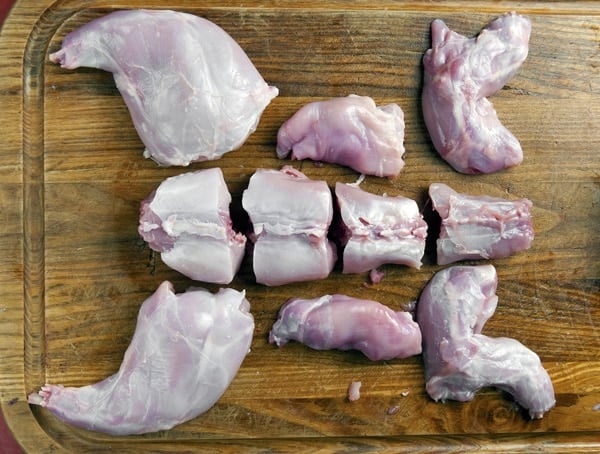
Butchering a rabbit is a bit harder than cutting up a chicken. In fact, that reason — along with a higher feed-to-meat ratio, is why America became a nation of chicken-eaters and not rabbit-eaters, a question actually in doubt a century ago.
Most of the rabbits and hares Holly and I eat are wild cottontails or jackrabbits, although an occasional snowshoe hare or domestic rabbit finds its way to our table. And it’s a domestic I decided to work with for this tutorial. They are all built the same.
Incidentally, when you are finished portioning out your rabbit, take a look at my collection of rabbit recipes. I am betting you’ll find a recipe you like there!
Why butcher your own rabbits? They’re cheaper, sometimes a full $1.50 a pound less than a pre-portioned bunny. Also, if you are raising your own or are a hunter, this is good information to know.
First you need a very sharp knife: I use a Global flexible boning knife, but a paring knife or a fillet knife would also work, as would a chef’s knife. I also use a Wusthof cleaver and a pair of kitchen shears. Have a clean towel handy to wipe your hands, and a bowl for trimmings.
Start by slicing off any silverskin and sinew from the outside of the carcass, mostly on the outside of the saddle.
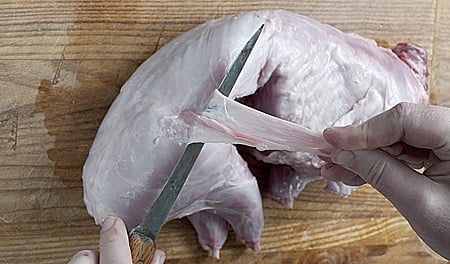
I always start cutting up a rabbit by removing the front legs, which are not attached to the body by bone. Slide your knife up from underneath, along the ribs, and slice through.
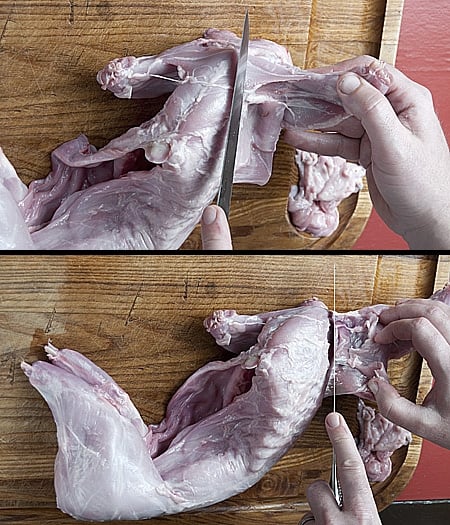
Usually there is some schmutz (a technical term) attached to the front leg that does not look like good eats: fat, sinew, and general non-meaty stuff. All can go into pate if you are so inclined. Or you can toss it.

Next comes the belly. A lot of people ignore this part, but if you think about it, it’s rabbit bacon! And who doesn’t like bacon? In practice, this belly flap becomes a lovely boneless bit in whatever dish you are making. Also good in pate or rillettes.
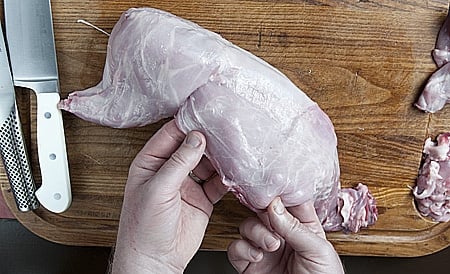
Turn Mr. Bunny over and slice right along the line where the saddle (or loin) starts, then run the knife along that edge to the ribs. When you get to the ribcage, you fillet the meat off the ribs, as far as you can go, which is usually where the front leg used to be. Finish by trimming more schmutz off the edge; if you’re using this part for pate or rillettes, leave the schmutz on.
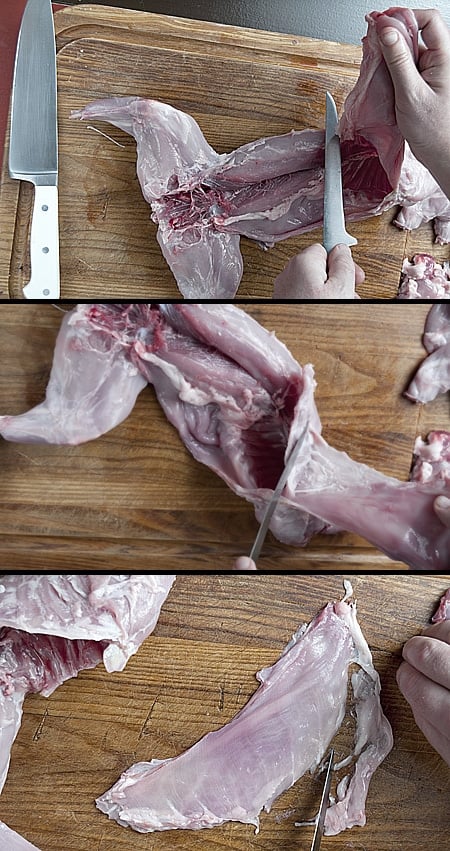
Up next, the hind legs, which is the money cut in a rabbit. Hunters take note: Aim far forward on a rabbit, because even if you shoot up the loin, you really want the hind legs clean — they can be a full 40 percent of a gutted carcass’ weight.
Start on the underside and slice gently along the pelvis bones until you get to the ball-and-socket joint. When you do, grasp either end firmly and bend it back to pop the joint. Then slice around the back leg with your knife to free it from the carcass.
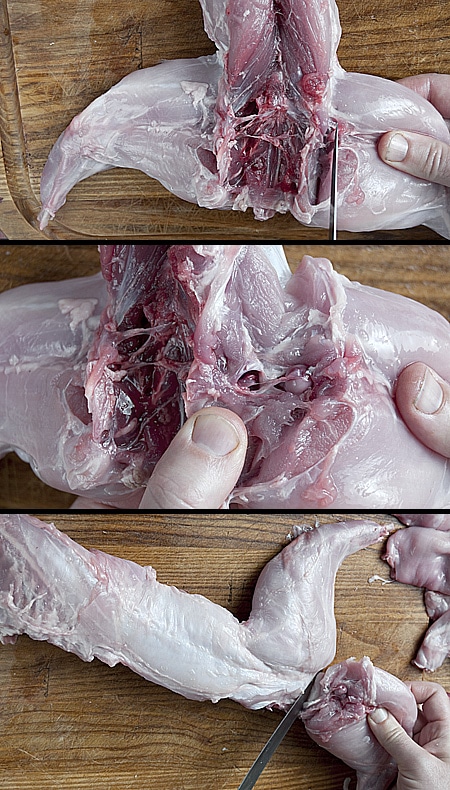
Once you’ve done both legs, you are left with the loin. It’s really the rabbit loin vs. chicken breast thing that did it in for the bunny as a major meat animal — there’s a larger swath of boneless meat in a chicken than in a rabbit. Both have a tendency to dry out, but then there’s that delicious chicken skin…
Now is a good time to remove a little more silverskin. The back of the loin has several layers, and most need to be removed. The final layer is very tough to cut off, and I often leave it. On a large hare or jackrabbit, however, this layer needs to go, too. Again, this stuff can be ground and used in pate.
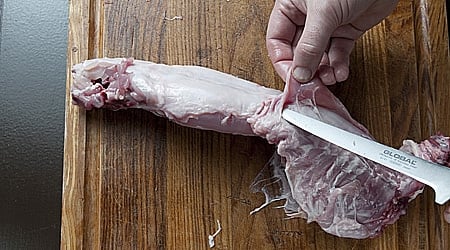
You’re now ready to portion the saddle. Ever heard the expression “long in the saddle?” It is an animal husbandry term: A longer stretch of saddle or loin means more high-dollar cuts come slaughter time. And meat rabbits have been bred to have a very long saddle compared to wild cottontails.
Start by removing the pelvis, which is really best in the stockpot. I do this by taking my cleaver severing the spine by banging the cleaver down with the meat of my palm. I then bend the whole shebang backwards and finish the cut with the boning knife. Or you could use stout kitchen shears.

Now you grab your kitchen shears and snip off the ribs, right at the line where the meat of the loin starts. The ribs go into the stockpot, too.

Guess what? There’s more silverskin to slice off. Could you do it all in one fell swoop? You bet, but it is delicate work and I like to break it up to keep my mental edge: The reason for all this delicate work is because the loin is softer than the silverskin, and if you cook it with the skin on, it will contract and push the loin meat out either side. Ugly. And besides, if you are making Kentucky Fried Rabbit, who wants to eat sinew?
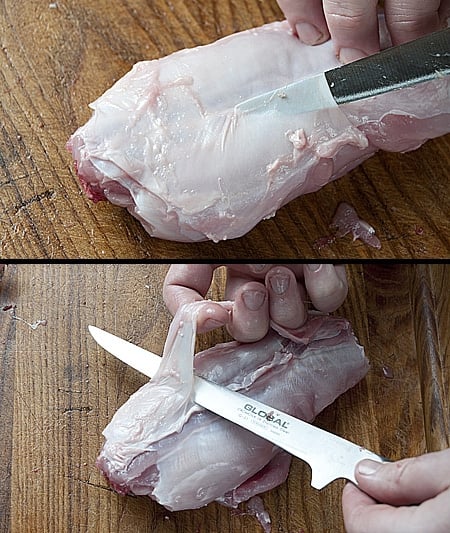
Your last step is to chop the loin into serving pieces. I do this by using my boning knife to slice a guide line through to the spine. Then I give the spine a whack with the cleaver or I snip it with kitchen shears.
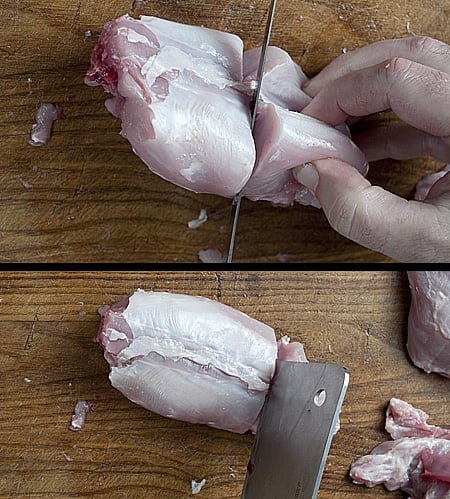
And voila! A bunny cut into lots of delicious serving pieces.
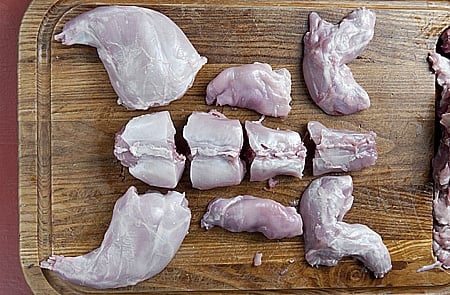
What about the offal, you say? I’ll do more on that later, but suffice to say rabbit livers and hearts are pretty much like those of a chicken. The kidneys are delicious, too. Remove the fat (rabbit fat tends to be foul-tasting) and peel the nearly-invisible membrane off the kidney before cooking.
What to do with your newly portioned rabbit? Well, you could browse through my rabbit recipes, as I mentioned above, but my favorite recipe is buttermilk fried rabbit. With an ice cold beer, it is every bit as good as it looks!
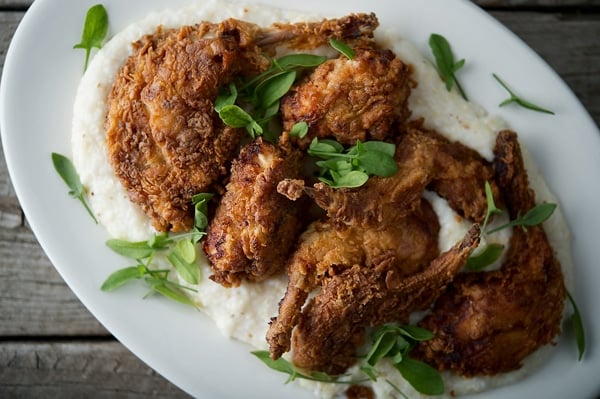
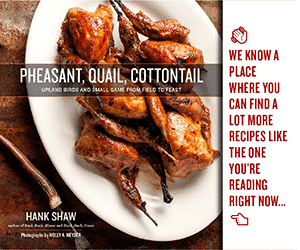





Funny, had a conversation about rabbit at dinner last night- how it is so wonderfully tasty yet we rarely eat it. Can you recommend the best source to purchase rabbit in the Sac area?
Dan, interesting point. I’ve certainly found that attitude toward venison among some families who had to hunt deer to eat during the Depression – they couldn’t wait to get away from it. Fascinating how our attitudes toward the meat affect flavor…
‘A lot of people ignore this part, but if you think about it, it’s rabbit bacon! And who doesn’t like bacon?’
Nice line
SBW
This is great! Thanks Hank, you’ve saved me hours, now I can direct all my rabbit break down questions from customers to your site for the step by step. The fried rabbit looks great also. I do have to disagree with one thing though – although rabbits feed to meat ratio is lower than chickens the feed cost is extremely lower than chicken feed ( being mostly dried alfalfa). In my research I have found that one possible reason that they have gone out of favor is that they were associated with deppression era food – cheap, and easy to raise. When times got better people still associated them with “cheap food”.
I thought the kidneys were only there (in whole, domestic bunneh) to assuage doubts in the buyer that what they are buying is, indeed a bunneh. I heard a rumor once that mini poodles have eerily similar anatomy to a rabbit, and were often sold as such to unwary customers until a crackdown from the USDA required kidneys – positioned differently in canids than in leporids – be left in place.
Anyways, I never thought rabbit kidneys were much for eating.
Hey, I still like tilapia. Just think what all those plants eat that we eat!
Paula: Not a huge amount of work once you get the hang of it – I can break down a rabbit like this in maybe 10 minutes or less. But it does take some practice to get there…
Bpaul: How’d the jackrabbit hunting go? I need to get out there before the jacks get too rangey in the hot weather.
Josh: Italian eat both, but the stat I cited was coniglio, not lepre. And yes, yogurt works very well for this recipe! But not on tilapia. Tilapia is the Soylent Green of fish. Nasty stuff…
Laura: Did that just for you!
Kevin: I am sure you can find whole rabbits in Belgium. Beer braise, maybe?
Jen: Yes, domestics are lighter in color and fleshier than their wild cousins. I prefer cottontails, actually, even though they are smaller.
Carol: GREAT idea! I was thinking about doing something like that as I was butchering, but I’ve never actually done it. Now I’ll need to, once rabbit season starts.
Matt: Practice, practice…
fantastic stuff. The best walk through of breaking down a rabbit that I have ever seen.
I have only done this a few times in my life and frankly no where near as elegantly as you have here. I do certainly remember all that darn silverskin though!
Great tutorial, Hank… thanks!
I love rabbit–don’t hunt so have to buy domestic rabbit at an *outrageous* price–and want to pass along a suggestion about the belly meat. If you want to serve it as an additional “cut”, roll each flap up like a jelly roll, perhaps with a strip of fatty bacon or a piece of scallion in the center, and secure it with toothpicks or kitchen twine (or, in one case where I had neither, a long piece of green from a scallion, blanched and cut into thinner strips–ties like string if you’re careful and survives the cooking process, which for me is usually braising). I love the kidneys and liver as a cook’s treat!
That was a great tutorial. I’ve been wasteful with my wild rabbits, as I make my first cut below the ribs and discard the front altogether. Never thought of rabbits as having belly meat / bacon.
The flesh on a domestic rabbit looks very different in colour and looks meatier than its wild counterpart. Chickeny. Thanks for the KFR recipe too.
Wow. I think that is TOTALLY impressive. Anyone who can butcher well is a bit of an artisan, I reckon. Fantastic photos too!! Really awesome post!!! Thank you!
Looks indeed quite a bit more tricky than a chicken. I like rabbit though so maybe I should give it a try. Not sure if a lot of places sell whole rabbits here (Belgium), but there must be…
Just seeing your Global knife already makes me want to put mine to work again. 😉
I love the final picture – deconstructed reconstructed rabbit.
Good stuff.
Is Italy eating rabbits or hares?
My fried anything recipe is now with homemade yogurt instead of buttermilk. It sticks better for me. Tilapia has been particularly good this way.
Yummaay!!!
Paula took the words out of my mouth — thanks for this. I never paid enough attention to the silverskin, for that alone this is a huge help to me. And to know that the fat is bitter, which I suspected but didn’t know.
We are going jackrabbit hunting in … less than 24 hours, so this was especially timely.
Bp
Hey, Hank – Thanks for the detailed step-by-step approach. I’ll review your pointers next time I get a snowshoe hare!
Oh yeah! This is something I have been thinking about for a while, but never asked. Hank, thanks for sharing! Going to do some more rabbit hunting this year and this will be an excellent guide.
Thanks for this! It looks like a lot of work, but someday it may be worth it if all you have between you and the wolf at the door is a rabbit raised at home! Or shot in the field….